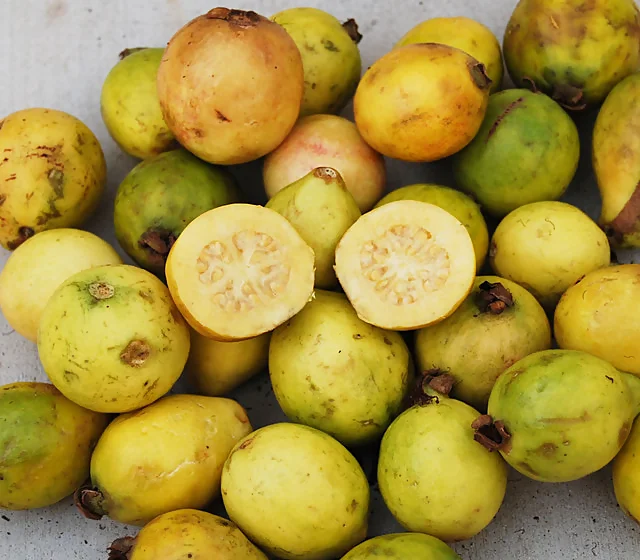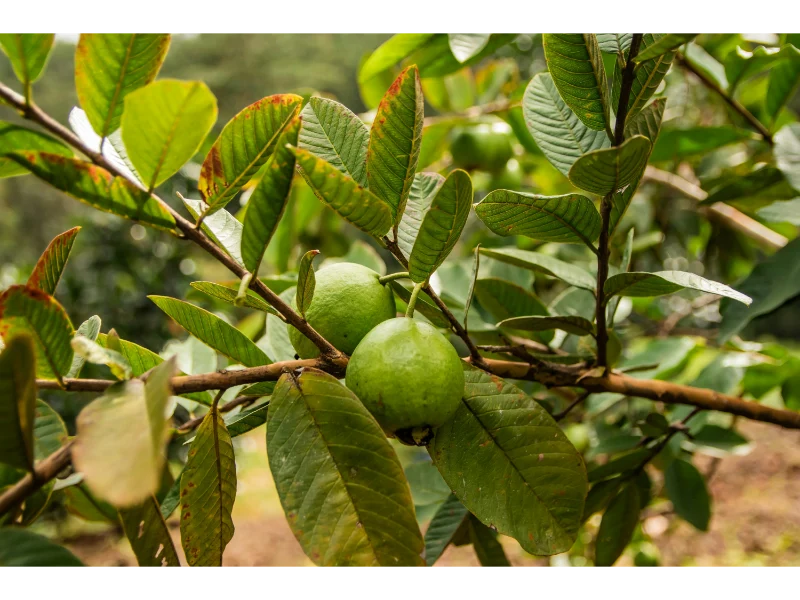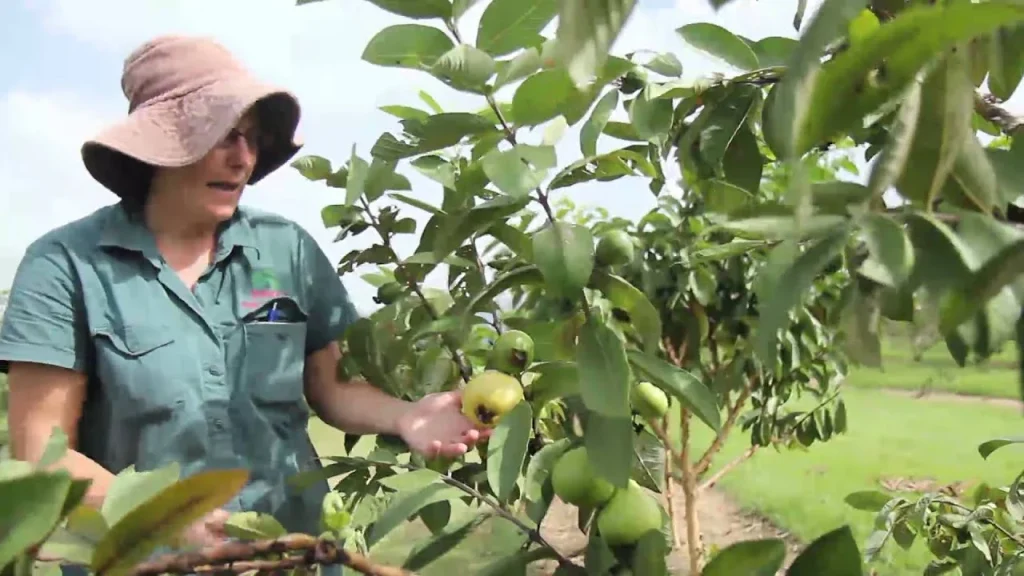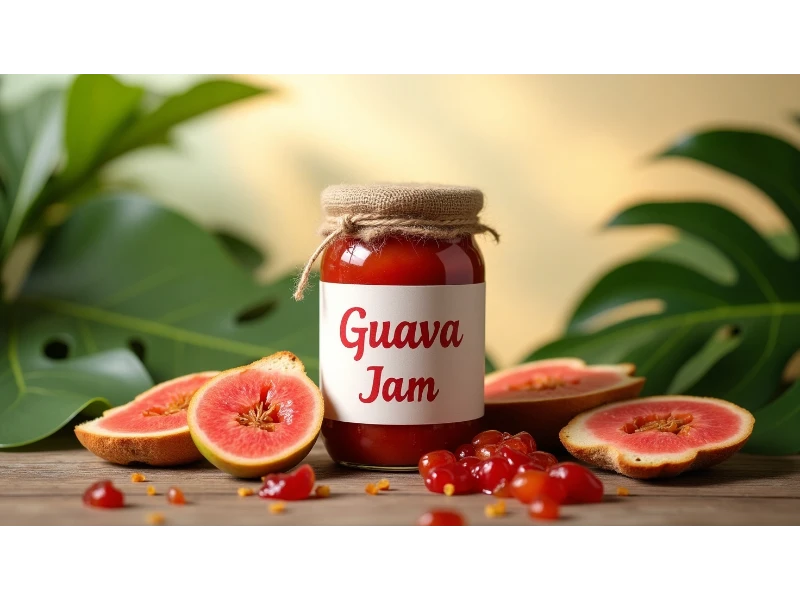
Mexican Cream Guava —The Sweet Safari Variety
Mexican Cream Guava, also known as “Mexican White” guava, is a tropical fruit native to Mexico and Central America. This variety is particularly noted for its creamy texture and distinctively sweet flavor.
The Mexican cream guava lives up to its dreamy name. These round green fruits encapsulate a sweet vanilla and strawberry essence. Their creamy white interior packs a nutritious punch too. Let’s explore why Mexican cream guava belongs on your fruit safari list!

Overview of Mexican Cream Guava
Mexican cream guava is a prized variety of common guava fruit belonging to the Myrtaceae plant family. In form, the oval rounded fruit has light green exterior skin covering its hallmark cream-colored flesh.
This interior creamy white pulp tastes subtly sweet and floral, reminiscent of wild strawberries or coconut cream. The aroma also evokes pleasant tropical vanilla notes.
Thriving in Mexico’s warm habitats, today Mexican cream guava appears in specialty groceries globally thanks to thriving export markets. Let’s uncover more about this delectable fruit.
Characteristics
- Flavor: The Mexican Cream Guava is exceptionally sweet with a creamy taste, making it a favorite among tropical fruit enthusiasts
- Appearance: The fruit typically has slightly yellow skin and white flesh. It is juicy and contains few seeds, enhancing its appeal for fresh consumption
- Aroma: This guava variety is known for its fragrant aroma, which adds to its desirability as a fresh fruit
Details on Mexican Cream Guava Fruits
The signature fruits contain sweet vanilla notes with strawberry and pear undertones. Each round oval guava reaches 5-10 cm in size when ripe.
The smooth thin exterior skin shifts from dark to light green. Cutting open the interior reveals the trademark creamy white hue enclosing a soft, moist pulp.
The flavor strikes a balanced sweetness and gentle acidity. Expect a milder profile compared to Red or Pink tropical guavas. The aroma also evokes coconutty vanilla scents.
Seeds do exist but are entirely edible. Some characterize their texture akin to pomegranate arils. Nutritionally, Mexican cream guavas deliver ample fiber, vitamin C, potassium and antioxidant compounds like lycopene.

Climate Needs for Mexican Cream Guava Trees
To yield the beloved fruits, Mexican cream guava requires tropical or subtropical climates without any winter freezes. Trees thrive best in hot, humid equatorial areas.
Mexican Cream Guava thrives in warm climates and requires well-drained soil. It can be grown in home gardens or orchards, providing both ornamental value and delicious fruit.
The oval evergreen leaves emerge along sparsely branched trunks that may reach 15 meters tall at maturity in ideal settings. Masses of white flower petals precede fruit emergence.
Well adapted to rainforests native to Mexico and Central America, Mexican cream guava trees need adequate water. Warm temperatures between 20°C to 35°C suit growth, with average annual precipitation levels around 1500mm preferred.
How can I propagate a Mexican Cream Guava tree?
Methods of Propagation
1. Seed Propagation
- Collect Seeds: Obtain seeds from ripe Mexican Cream Guava fruit. Clean the seeds to remove any pulp.
- Prepare Soil: Use a well-draining potting mix. A mix of sand and compost works well.
- Plant Seeds: Sow the seeds about 1/4 inch deep in the soil.
- Watering: Keep the soil moist but not soggy. Use a spray bottle for gentle watering.
- Light: Place the pots in a warm area with indirect sunlight until germination occurs, which may take several weeks.
2. Cutting Propagation
- Select Cuttings: Choose healthy, semi-hardwood cuttings from a mature tree, ideally during late spring or early summer.
- Prepare Cuttings: Cut sections about 6-8 inches long, ensuring each cutting has several leaves and at least one node.
- Rooting Hormone: Dip the cut end of each cutting in rooting hormone to promote root development.
- Plant Cuttings: Insert the cuttings into a pot filled with a well-draining mix. Water lightly.
- Humidity: Cover the pot with a plastic bag or dome to maintain humidity until roots develop, which may take several weeks.
3. Grafting
- Choose Rootstock: Use a healthy guava tree as rootstock.
- Select Scion Wood: Take a healthy branch from a Mexican Cream Guava tree.
- Graft Together: Make a clean cut on both the rootstock and scion and join them together, securing with grafting tape.
- Care for Graft: Keep the grafted area moist and shaded until it takes hold.
General Care Tips
- Ensure that young plants receive plenty of sunlight (80-100% sunlight is ideal) and are watered regularly without waterlogging the soil
- For best results, transplant seedlings or rooted cuttings into larger pots or directly into the ground once they are strong enough to handle.
By following these methods, you can successfully propagate your own Mexican Cream Guava trees.

Consumption Uses for Mexican Cream Guava
Mexican Cream Guava, known scientifically as Psidium guajava, is a tropical fruit celebrated for its unique flavor and versatility in culinary applications. Here are the primary consumption uses for this fruit:
“In Mexican cuisine, guava is not only valued for its taste but also for its cultural significance. Various processed products such as candies, ice creams, and sauces highlight its importance in traditional dishes”
Consumpting it fresh
- Raw Eating: The Mexican Cream Guava can be enjoyed fresh. Its creamy white flesh is thick and sweet, making it ideal for eating raw. Simply wash the fruit, slice it, and consume it as a snack or add it to fruit salads.
- Pairing: It pairs well with a sprinkle of salt or chili powder, enhancing its natural sweetness with a savory twist
Culinary Uses
- Jams and Jellies: The guava’s high pectin content makes it suitable for making jams and jellies. Cooking the pulp with sugar creates a spreadable treat that captures the fruit’s flavor.
- Guava Paste: This concentrated form of guava can be used in both sweet and savory dishes. It serves as a filling for pastries or as a glaze for meats, adding a tropical flavor to various recipes.
- Desserts: Guavas can be incorporated into pies, tarts, and cobblers. Their natural sweetness complements baked goods beautifully.
Beverages
- Juices and Smoothies: Guava juice is a popular way to enjoy this fruit. It can be made by blending ripe guavas with water and straining the mixture. This juice can also be mixed with other fruit juices or sparkling water for a refreshing drink.
- Cocktails: Guava nectar, a thicker version of guava juice, is often used in cocktails and mocktails, providing a sweet tropical flavo

How to Make Mexican Cream Guava Fruit Jelly
- Things You’ll need:
- 4 cups fruit juice (extracted from fresh fruit or store-bought)
- 4 cups sugar
- 1 package powdered pectin
- Clean mason jars with lids
- Extract juice from fruit by cooking and straining, or use store-bought juice
- Combine juice and pectin in a large pot. Bring to a rolling boil while stirring
- Add sugar all at once, return to boil, and cook for exactly 1 minute while stirring
- Remove from heat, skim off foam
- Pour into sterilized jars, leaving ¼-inch headspace
- Place in water for 10 minutes until cool
Medicinal Uses

The guava plant has traditional medicinal applications, particularly in Mexico. Infusions made from its leaves are used to treat various ailments such as diarrhea, coughs, and stomach pain. Additionally, extracts from guava are recognized for their antioxidant properties and potential health benefits, including lowering blood sugar levels and promoting heart health.
The various parts of the guava plant, including the fruit, leaves, and even bark, have been utilized in traditional medicine across many cultures for their health benefits.
10 Health benefits of guava leaves

- Digestive Health: Guava is rich in dietary fiber, which aids in digestion and promotes regular bowel movements. It can help alleviate symptoms of gastric issues and ulcers when consumed with the peel.
- Immune System Support: High in vitamin C, guava enhances the immune system’s functionality, making the body more resilient against infections.
- Diarrhea Relief: Guava leaf extracts possess astringent and antimicrobial properties that can effectively treat both acute and chronic diarrhea. Drinking guava leaf tea is a common remedy.
- Weight Management: The fiber content in guava helps in weight management by promoting a feeling of fullness and reducing overall calorie intake.
- Blood Sugar Regulation: Guava has been shown to help regulate blood sugar levels due to its high fiber content and specific compounds in the leaves that assist in managing glycemic metabolism.
- Cholesterol Control: The soluble fiber in guava can lower LDL cholesterol levels and improve overall heart health by preventing cholesterol absorption.
- Menstrual Pain Relief: Guava leaf extracts may alleviate menstrual cramps due to their analgesic properties.
- Cancer Prevention: Antioxidants found in guava leaves, such as quercetin, have been studied for their potential to prevent certain types of cancer by combating oxidative stress and inflammation.
- Skin Health: The antimicrobial properties of guava can benefit skin health by helping to treat acne and other skin conditions when applied topically or consumed.
- Anemia Prevention: Vitamin C in guava enhances iron absorption, making it beneficial for preventing anemia when consumed alongside iron-rich foods.
Conclusion
Mexican Cream Guava represents a delightful fusion of flavor and nutrition, offering a unique tropical fruit experience with its vanilla-strawberry essence and creamy white flesh.
Whether enjoyed fresh, incorporated into various culinary creations, or grown in suitable home gardens, this versatile fruit provides both gastronomic pleasure and significant health benefits.
Its seasonal availability from September through November makes it a special treat worth seeking out, while its adaptability to different culinary applications ensures multiple ways to enjoy its distinctive taste.
For those interested in exploring tropical fruits, Mexican Cream Guava stands out as a must-try variety that combines exotic appeal with practical versatility.
Frequently Asked Questions
What does Mexican Cream Guava taste like?
Mexican Cream Guava has a subtly sweet and floral taste, reminiscent of wild strawberries and coconut cream, with vanilla notes. Its flavor is milder compared to Red or Pink guavas.
What are the main nutritional benefits?
It’s rich in Vitamin C (628% daily value), contains antioxidants like lycopene, provides fiber, and offers minerals like potassium and magnesium. It’s also low-calorie at about 55 calories per 100 grams.
When is Mexican Cream Guava in season?
The harvest season runs from September through November.
Can I grow Mexican Cream Guava at home?
Yes, if you live in Zones 9-11. The trees need tropical or subtropical climates, well-draining fertile soil, and full sun. They can be grown from grafted saplings or seeds, though seeds take 5+ years to produce fruit.
How can Mexican Cream Guava be used?
It can be eaten fresh or used in juices, jellies, preserves, baked goods, ice creams, salads, and desserts
Contents
- 1 Mexican Cream Guava —The Sweet Safari Variety
- 1.1 Overview of Mexican Cream Guava
- 1.2 Climate Needs for Mexican Cream Guava Trees
- 1.3 How can I propagate a Mexican Cream Guava tree?
- 1.4 General Care Tips
- 1.5 Consumption Uses for Mexican Cream Guava
- 1.6 Consumpting it fresh
- 1.7 Culinary Uses
- 1.8 Beverages
- 1.9 How to Make Mexican Cream Guava Fruit Jelly
- 1.10 Medicinal Uses
- 1.11 10 Health benefits of guava leaves
- 1.12 Conclusion
- 1.13 Frequently Asked Questions
- 1.14 What does Mexican Cream Guava taste like?
- 1.15 What are the main nutritional benefits?
- 1.16 When is Mexican Cream Guava in season?
- 1.17 Can I grow Mexican Cream Guava at home?
- 1.18 How can Mexican Cream Guava be used?

